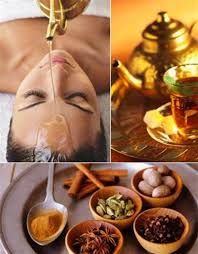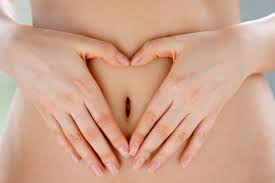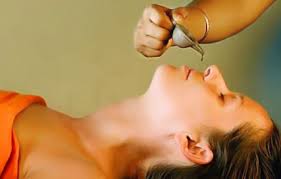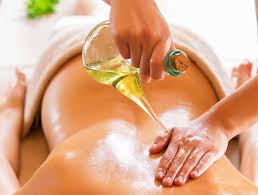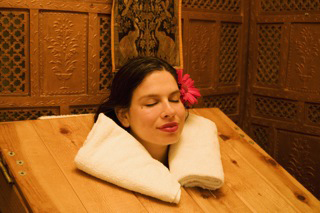Āyurveda
Pañcakarma therapies — a detoxifying and rejuvenating technique
Abstract
Pañcakarma refers to a unique therapeutic measure in Āyurveda which is useful for sick as well as healthy individuals. These methods are useful in curing as well as preventing diseases. It also helps in the rejuvenation of body tissues. Pañcakarma usually refers to the five therapeutic procedures of vamana, virecana, nasya, vasti and raktamokṣaṇa. It also includes the associated processes of snehana and svedana. This article gives an elaborate understanding of the basic processes in a lucid manner which can help a reader unfamiliar with Āyurveda understand these concepts easily.
Various mechanisms are applied by Mother Nature to safeguard the integrity of its individuals. Vomiting and diarrhoea are two such phenomena which restore equilibrium of the body through elimination of harmful things. It is a common observation that animals like cats and dogs consume some herbs for throwing up.
Practitioners of Āyurveda have brilliantly used this principle to rid the body of hazardous things through Pañckarma therapies (1). Pañckarma is a unique concept of Āyurveda that can be used for prevention of diseases in healthy individuals, restoration of health in sick persons and rejuvenation of body tissues (2).
The body is made up of three fundamental units — doṣa, dhātu and mala (3). The doṣa (vāta, pitta and kapha) are governing factors of the body. Any type of movement in the body, whether voluntary or involuntary is under the influence of vāta (4). Pitta brings about transformation of consumed things into products suitable to the body for use (5). Kaphadoṣa uses assimilated food for restoration and building-up of body tissues (6). Dhātu are the seven body tissues where functional units of body, i.e. doṣa, reside and carry out their functions (7,8). Each dhātu is attributed a specific function in the body. Mala are the waste metabolic products which are retained in the body for a specific period and then eliminated as stool, urine, sweat, ear wax or nasal secretions (9). Doṣa, dhātu and mala work in harmony to maintain equilibrium and achieve optimal functioning of the body (10).
Pañcakarma includes five major eradication procedures like vamana (emesis), virecana (purgation), nasya (medicines through nasal route), vasti (medicines through anal route) and raktamokṣana (blood removal). snehana (oral consumption of processed fats and external application) and svedana (fomentation) are essential prerequisites before eradication of doṣa (11).
Āyurveda believes that digestive disturbance (Agni-vikṛti) is the cause of almost all diseases (12). According to various phases of digestion, the origin of pathogenesis can be related to āmāśaya (stomach), adho-amaśaya (part of small intestine) and pakvāśaya (large intestine) (13). Incidentally, āmāśaya is the main seat of kaphadoṣa, Adho-āmāśaya of pittadoṣa and pakvāśaya is the main place of vātadoṣa (14).
Planetary movements, especially of the sun, moon and earth, control atmospheric changes on earth (15). Climatic changes caused by them influence the bodies of living organisms and consequently affect the harmony of doṣa (16). Doṣa accumulate naturally according to seasonal changes, leading to their imbalance in the body. They can be pathogenetic if not controlled in time. Āyurveda guides ahāra-vihāra (dietary regimen and routine) to combat such imbalances. But if vitiated the doṣa are more resistant and need to be removed from the body through seasonal pañcakarma. Thus pañcakarma is carried out in healthy individuals for maintaining health according to the specific season.
Kaphadoṣa accumulates in winter and vitiates in spring, Pitta accumulates during the rainy season and vitiates around October (Śarada Ṛtu) and vāta accumulates during summer and vitiates during the first part of the rainy season.
Vamana (emesis)
This is the main treatment to maintain balance of kaphadoṣa and prevent diseases originating from āmāśaya. Virecana (purgation) takes care of pittadoṣa and ādho-āmāśaya, while vātadoṣa, the leader of all other doṣas, is controlled by vasti therapy (17). Vasti forms the main treatment for diseases originating in pakvaśaya. Thus vamana and virecana are indicated for purification of body tissues in skin diseases, gastro-duodenal disorders, migraine, cervical problems, respiratory problems, constipation, etc. (18). Vasti is mainly used in digestive (colitis, constipation, distension, etc.), musculoskeletal (osteoarthritis, rheumatoid arthritis, spasticity, wasting, etc.) and neurological (spinal injuries, brain related pathologies, etc.) diseases (19). Vasti is a unique treatment in Āyurveda aimed at the use of rich neurological and venous plexuses in the large intestine. Usage of a variety of medicines makes vasti highly effective in numerous conditions ranging from weight-reduction or gain and oedema to treatment of eye ailments.
Nasya therapy
It aims at ailments pertaining to the region of the body above the clavicle bones. The nostrils provide an easy access for medicines to reach parts of the head region, including the sinuses, sensory organs and parts of the brain. Medicines (oil or ghee based decoctions, medicinal juices, medicinal powders or fumes) are given in the nostrils of patients in different dosages according to the needs of the case. Thus nasya is an effective therapy in ENT diseases and problems in the eyes, teeth and gums, memory issues, epilepsy, brain tissue damages, paralysis, cervical pathologies and headaches as well as hair problems (20).
Raktamokshan (blood-letting)
This course relieves itching, burning, redness, swelling and pain. Hence it is indicated in skin diseases, herpes, abscess, etc. and to reduce hypertension. It is used as a means of acute pain relief even in cases of sciatica, headaches or plantar fasciitis, etc.
Nowadays, the food and water that we consume have become highly polluted and the immunity of people is in a compromised state. As a result, a variety of lifestyle disorders as well as infectious diseases have popped up. Though life-expectancy has increased due to a modernised lifestyle, the quality of life is hugely affected.
Thus detoxification therapies like pañcakarma can be a great boon in such situations. Pañcakarma is a preliminary qualification for rasāyana (rejuvenation) and vājīkaraṇa (infertility and sexual disorders) therapies (21). The main aim of pañcakarma therapies is to maintain patency of bodily channels on macro and microscopic levels for smooth functioning of doṣa, dhātu and mala.
Preparation of the body with snehana (anointing) and svedana (fomentation) is essential before pañcakarma as they separate removable doṣa from dhātu and mala for removal (22).
Many allied therapies are included under ‘pañcakarma’ which are not eradicators but which help in numerous health issues. These are extensions of snehana and svedana therapies described in classical Āyurvedic texts. Āyurveda suggests that application of medicated fats on the body pacifies vātadosha. By virtue of medicines used for processing oils, ghee or bone marrow, they can also act on pitta and kaphadoṣa. Fomentation directly pacifies vāta and kapha and helps to relieve pain, swelling, stiffness and improve mobility of body parts.
Abhyanga (massage)
Application of medicated oil or ghee is a must in almost all pañcakarma therapies. It rejuvenates the body by improving circulation. Many neuro-transmitters (serotonic, dopamine, endorphins) are released in the body due to massage therapy and it also helps to activate the parasympathetic state, reducing levels of epinephrine, norepinephrine and cortisol, thus offering psychological well-being as well (23). Massage done for a particular time-period improves the tone of particular tissues in the body (24). Āyurveda suggests regular massage for optimal physical and mental functioning. At least the scalp, ears and feet should be regularly anointed (25).
Śiroabhyanga, Śirodhara
Śira is considered as an uttama (highly organised) body-part as it is the seat of the brain. Svedana therapy is particularly useful in relieving stiffness, heaviness and pain in the body- parts, including muscles and joints. It can be done locally or for the whole body and with or without abhyanga. Svedana is given by using the steam of herbal decoctions, direct and sensory organs. Śira is the region of many vital points (marma) which are a junction of important joints and circulatory and neurological tissues. Pathologies in the scalp and head region can be treated using the above mentioned procedures along with nasya. They are more potent in the ascending order.
Śiroabhyanga is massage in the scalp region. It is helpful in treating dryness of hair and scalp, itching, dandruff, insomnia etc. In śirodhara therapy, decoctions or medicated milk, buttermilk and oil are poured on the forehead and scalp in a uniform sustained motion. It is useful in headaches, burning sensations in the head, mental diseases, sleep disorders, hypertension, etc. Takradhara is a specialised treatment of hair and skin diseases like psoriasis. Śirodhara is a potent stress reliever and mood-enhancer.
Svedana (fomentation)
Svedana therapy is particularly useful in relieving stiffness, heaviness and pain in the body-parts, including muscles and joints. It can be done locally or for the whole body and with or without abhyanga. Svedana is given by using steam of herbal decoctions, direct application of heated medicines or equipments or by pouring warm medicines (decoctions or oils) on painful body parts. Patients are also seated in the tubs of warm decoctions or oils in case of need in avagaha type of sweda.
We always take pride in discussing the rich heritage of India. Āyurveda is a part of this tradition. Āyurveda came into being when diseases were incapacitating people from carrying out their duties because of illnesses. After thousands of years of existence and despite thehurdles, Āyurveda is still catering to the needs of the people. Health can be achieved in the real sense through Āyurveda if every Indian with a scientific mind values this science of life and uses it for one’s benefit to its fullest capacity.
References
1. Agnivessa. Caraka saṁhitā, with Dipika commentary by Cakrapaannidutta, re-print ed. 2007. Varanasi: Chaukhambha Prakashana, C.Su.16/20-21; p. 97.
2. Vagbhatta. Aṣtānga Hṛdayam, re-print ed. 2007. Varanasi: Chaukhambha Prakashana, A.H.Su.13/35; p. 99.
3. Ibid., A.H.Su 11/1; p.85.
4. Suśruta. Suśruta saṁhitā with Nibandhasaṅgraha Commentary by Sri Dalhanachrya. 8th ed. Varanisi: Chaukhambha Orientalia; 2005, S.Ni.1/7, 8, 10; p. 257.
5. Ibid., S. Su.15/2-4; p. 67.
6. Ibid., S. Su 15/4.
7. Vagbhatta. Aṣtānga Hṛdayam, A.H.Su.11/26; p. 88.
8. Ibid., p. 7.
9. Agniveśa. Caraka saṁhitā, C. Su. 28/4; p. 175.
10. Suśruta. Suśruta saṁhitā, S. Su. 15/41; p. 75.
11. Agniveśa. Caraka saṁhitā, C. Su. 2/15; p. 25.
12. Vagbhatta. Aṣtānga Hṛdayam, A.H. Ni. 12/1; p. 263.
13. Agniveśa. Caraka saṁhitā, C. Chi. 15/9-11; p. 512.
14. Suśruta. Suśruta saṁhitā, S.Su. 21/6, p. 24.
15. Ibid., S.Su.6/4, p. 24.
16. Ibid., S. Su. 6/7, p. 25.
17. Vagbhatta. Aṣtānga Hṛdayam, A.H.Su.1/25-26; p. 12.
18. Agnivessa. Caraka saṁhitā, C.Si.2/10,13; pp. 687-8., pp. 687-8.
19. Ibid., C.Si.2/16; p. 689.
20. Ibid., C.Si.2/22; p. 690.
21. Ibid., C.Chi 1-1/24; p, 377.
22. Vagbhatta. Aṣtānga Hṛdayam A.H.Su.17/29; p. 114.
23. Paglia M. How Massage Affects Your Mood, The science behind that post-massage bliss. LMT Mar 20, 2017.
24. Sussruta. Suśruta saṁhitā, S. Chi. 24/30; p. 488.
25. Vagbhatta. Aṣtānga Hṛdayam, A.H.Su.2/8-9, p. 20.
Dr. Gayatri Gandhe is Professor and Head of the Panchkarma Dept. at G.J. Patel Ayurveda College in Anand, Gujarat.
Share with us (Comments,contributions,opinions)
When reproducing this feature, please credit NAMAH,and give the byline. Please send us cuttings.

